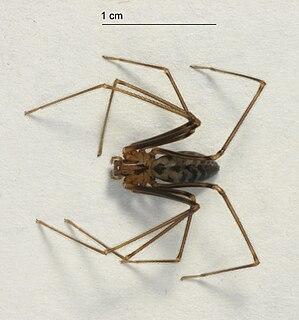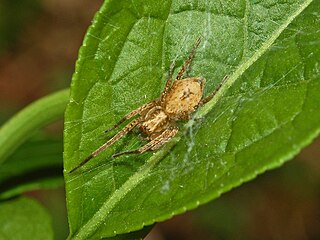
Ground spiders comprise Gnaphosidae, the seventh largest spider family with nearly 2,000 described species in over 100 genera distributed worldwide. There are 105 species known to central Europe, and common genera include Gnaphosa, Drassodes, Micaria, Cesonia, Zelotes and many others. They are closely related to Clubionidae. At present, no ground spiders are known to be seriously venomous to humans.

Anasaitis is a genus of jumping spiders that was first described by E. B. Bryant in 1950. The name is derived from the salticid genus Saitis.

Drymusa is a genus of false violin spiders that was first described by Eugène Simon in 1892. They physically resemble violin spiders (Loxosceles), but their bites are not believed to be medically significant. Originally placed with the spitting spiders, it was moved to the Loxoscelidae in 1981, then to the Drymusidae in 1986.

Anyphaena is a genus of anyphaenid sac spiders first described by Carl Jakob Sundevall in 1833.

Cubanops is a genus of Caribbean araneomorph spiders in the family Caponiidae first described by A. Sánchez-Ruiz, Norman I. Platnick & N. Dupérré in 2010. These spiders are wandering hunters, generally found at ground level, under stones, in leaf litter or in the soil, and have only been found in the West Indies.

Nops is a genus of medium-sized South American, Central American, and Caribbean spiders in the family Caponiidae, first described by Alexander Macleay in 1839. It has a great richness on the Caribbean islands, and most mainland species are located in high proportion toward the Caribbean coast. It likely has a neotropical distribution, though most species of South America are known only from the coast of Colombia and Venezuela, including the islands of Aruba, Curaçao, Bonaire and Trinidad.

Ceraticelus is a genus of dwarf spiders that was first described by Eugène Louis Simon in 1884.

Ctenus is a genus of wandering spiders first described by Charles Athanase Walckenaer in 1805. It is widely distributed, from South America through Africa to East Asia. Little is known about the toxic potential of the genus Ctenus, however, it was recently discovered that the species Ctenus medius shares toxic properties with those presented by Phoneutria nigriventer, such as proteolytic, hyaluronidase and phospholipase activities, in addition to producing hyperalgesia and edema, the venom of C. medius also interferes with the complement system in concentrations in which the venom of P. nigriventer is inactive, indicating that this spider has a noxious venom to humans. The venom of C. medius causes an eleavage in the complement component 3 (C3) of the complement system, it affects the central factor of the cascades of the complement, and interferes with the lytic activity of this system, which causes stronger activation and consumption of the complement components. Unlike C. medius, the venom of P. nigriventer does not interfere with lytic activity.
Barronopsis is a genus of funnel weavers first described by R. V. Chamberlin & Ivie in 1941.

Tarsonops is a genus of araneomorph spiders in the family Caponiidae, first described by Ralph Vary Chamberlin in 1924.
Pozonia is a genus of orb-weaver spiders first described by E. Schenkel in 1953.

Sergiolus is a genus of ground spiders that was first described by Eugène Simon in 1892. They are 3.3 to 9 millimetres long.

Hamataliwa is a genus of lynx spiders that was first described by Eugen von Keyserling in 1887.
Modisimus is a genus of cellar spiders that was first described by Eugène Louis Simon in 1893.

Grammonota is a genus of dwarf spiders that was first described by James Henry Emerton in 1882.
Xenoctenidae is a family of araneomorph spiders separated from Miturgidae in 2017.











